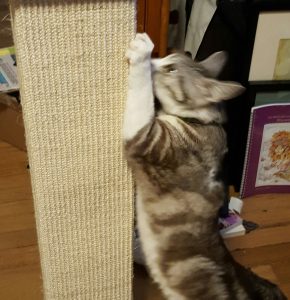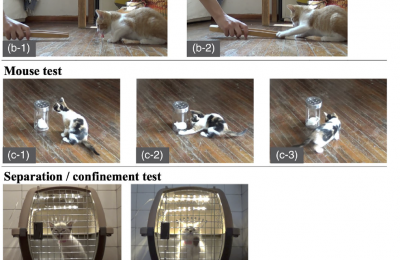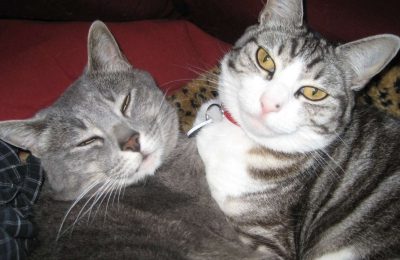Some behaviors that cat owners find problematic are in many cases just normal cat behaviors. Scratching is one of those commonly reported “nuisance behaviors” which is a perfectly natural behavior for cats. However, if not directed toward acceptable objects, feline scratching can lead to humans living with shredded couches; in some cases humans resort to painful and potentially harmful procedures, such as amputation of the cat’s toes (commonly referred to as “declawing”; I’ve written about the potential harms of declawing here).
A new study aimed to learn more about what cats scratch in homes, and what owners do in response. The results of the study, “Survey of cat owners on features of, and preventative measures for, feline scratching of inappropriate objects: a pilot study” were recently published in the Journal of Feline Medicine and Surgery.
One hundred and sixteen cat owners who brought their cats to the veterinary clinic at the University of Georgia participated in the survey. In addition to your usual household demographic questions, participants were asked if their cat scratched any objects “not designated for scratching” and if so, to describe the type of object, the material, and the angle of the object in relation to the floor (e.g., horizontal or vertical). They were asked to detail how often their cat scratched the object(s) in question, the techniques they used to stop scratching behavior, whether they provided their cat with designated items for scratching, and how they encouraged their cat to use the designated item.
The cats in the study ranged in age from 1 month to 18 years, were pretty evenly distributed between the sexes, and were mostly (79.3%) indoors-only and spayed/neutered (85.2%). Eighty-seven percent of cats still had their claws (why include declawed cats in a study of undesirable scratching behavior?).
A whopping 83.9% of respondents reported that their cat scratched inappropriate items, with the majority of cats scratching said items daily. Cats overall preferred fabric chairs, sofas and other furniture – primarily things that are vertical in relation to the floor – but they also really loved carpets for scratching. Despite the frequency and type of objects scratched, owners estimated the damage at less than $100 for more scratching (y’all got some cheap couches in Georgia?).
Owners reported several ways they tried to get their cats to stop scratching, including yelling, spanking, spraying water on their cat, covering furniture with tinfoil, and providing their cat with a designated scratching item. None of these techniques was related to the reported frequency of “inappropriate scratching.”
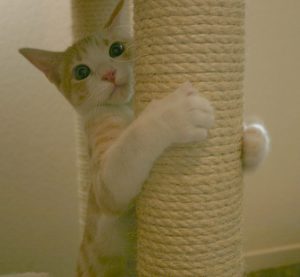
Most cats (76.1%) were provided with a designated scratching item, often a scratching pole or pad. Most poles were carpet, sisal or a combination of the two; and most scratch pads were made of cardboard. Cat owners also had several methods for trying to get their cat to use the scratching item, including praise, catnip, treats, playing with a toy nearby, or placing their cat near the scratching item. No particular method was associated with success or failure, except placing the cat nearby, which was associated with less, not more, success.
The study gives us some insight into what cats are doing in the homes, and what humans are doing in response. I have a few minor quibbles with the study, one being that the data is really old – collected in 2011; in the past seven years, there’s been a bit of a cat “renaissance” – the options for cat trees and scratching objects has really expanded and hopefully nowadays cats are being provided with more and better options for scratching (I can dare to dream, can’t I?).
The sample size is relatively small, focuses on cat owners in one city, and we don’t know how representative it is of all cat owners. That said, internet samples have their own problem in that pet owners who are willing to fill out surveys are also not always representative of all pet owners, so it’s nice to see a study that relied on pen and paper surveys with real people!
Many cats in this study were provided with scratching items, but still scratched other things. Whether the designated scratching items met cats’ needs is hard to determine. The average height of vertical scratching poles provided by study participants was between 2 and 3 feet tall, which falls short of the height and sturdiness that many cats prefer – there’s a reason they love sofas – they’re tall and sturdy, and usually in a good spot for the territorial marking that scratching behavior in part represents. Although 22.1% of people who tried to encourage their cat to use the designated item gave their cats treats for scratching, only one person reported using clicker training to do so.
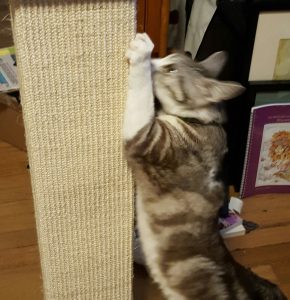
There was almost no relationship between human behavior and cat scratching behavior, but there could be too much variability in human behavior to see an effect; for example, did everyone in the study who “taught their cat how to use the designated scratching item” do so in exactly the same way? I’m guessing not.
So what can we conclude from this study? Many cats scratch chairs and carpet; but almost as many cats (79% of those who had a provided scratch post or pad) were ALSO using their designated scratching posts or pads. Most cats in the study were only provided with one designated scratching option, so one may not be enough. My own personal and professional experience: give your cat multiple scratching options that they like, in different areas of your house, and they will rarely if ever touch your furniture. Offer choices and you’ll learn their scratching preferences in no time…and save your couch from being shredded too.
Reference: Moesta, A., Keys, D., & Crowell-Davis, S. (2017). Survey of cat owners on features and preventative measures of feline scratching of inappropriate objects: a pilot study. Journal of feline medicine and surgery, 1098612X17733185.

